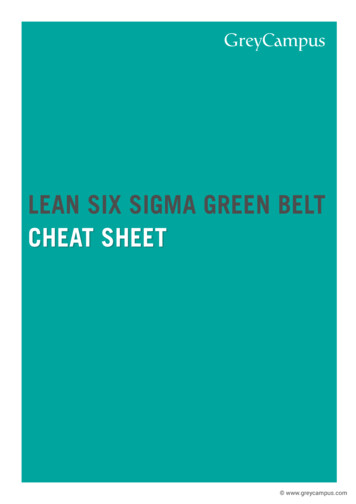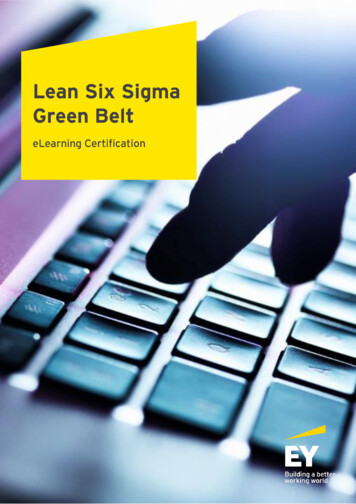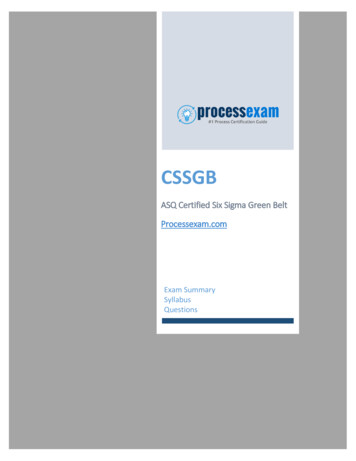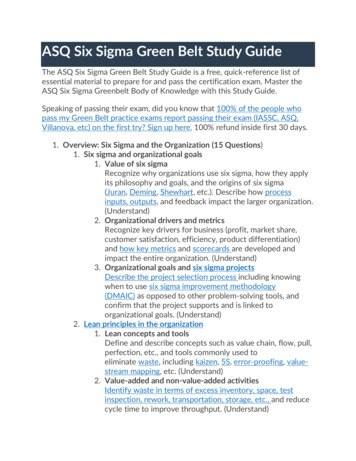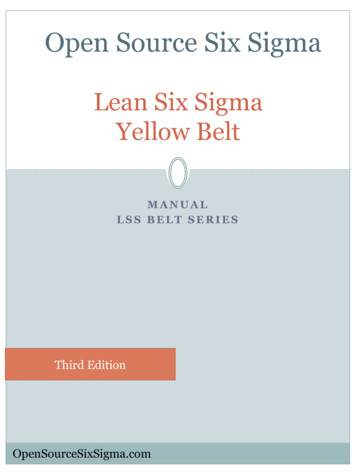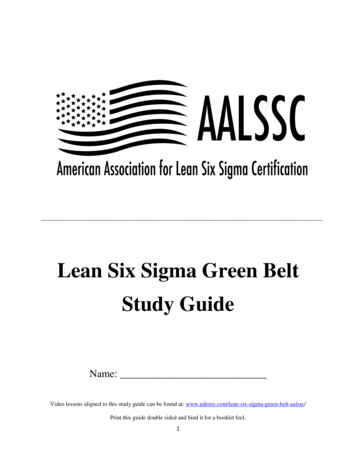
Transcription
--------------------------------------------Lean Six Sigma Green BeltStudy GuideName:Video lessons aligned to this study guide can be found at: nt this guide double sided and bind it for a booklet feel.1
Letter from the DirectorFirst, let me congratulate you for pursing your Lean Six Sigma Green Belt certification and welcome to the AmericanAssociation for Lean Six Sigma Certification (AALSSC). Obtaining a Lean Six Sigma certification is one of the mostrewarding and valuable professional accomplishments you can achieve. The professional opportunities for a Lean SixSigma Green Belt are vast and apply all industries. This is an exciting time for Lean Six Sigma professionals and let mebe the first to welcome you to the community.The amount of knowledge required for an AALSSC certification is extensive, but not overwhelming. You can do it! Thecore tenants of AALSSC certifications is they must be relevant and attainable. By only testing the most relevant tools andmethods within Lean Six Sigma we have removed some of the knowledge areas deemed not relevant enough – thusmaking the exam more attainable. As a certified Lean Six Sigma Green Belt you will be expected to effectively facilitateteams, be a process improvement specialist, and a problem solving expert. The exam tests your knowledge, skills andabilities across these focus areas.This is your study guide, treat it as such. Write your name on it, complete it using your words and follow the conceptsoutlined. By writing you will retain the information and make this study guide a useful part of your reference library. Plus,this study guide can be used when taking an AALSSC Green Belt certification exam.Good luck and welcome to AALSSC – your road to success.Erik ChristensenMr. Erik ChristensenDirector of Certification, AALSSC2
Table of ContentsSection #1 - IntroductionBackgroundThe Green Belt’s impactSection #2 – Lean Six Sigma overview and process mappingSix Sigma overviewLean overviewTIM WOOD (U)Principles of LeanSeeing the processTiming the value stream and action planningSection #3 - FacilitationTeam facilitationFacilitation – facilitator toolsTeam facilitation - stages of team developmentFacilitation - decision makingFacilitation - team members and eventsSection #4 - Problem solvingProblem solvingChange management and stakeholdersProblem solving – SWOT and SMARTRoot Cause Analysis toolsSection #5 – Lean Six Sigma countermeasures5S, standard work and visual managementPoka-Yoke, quick changeover, leveling and cell designSustainment actions3
Section #1 - IntroductionBackgroundLean Six Sigma:Lean Six Sigma is the combining of two methodologies – Lean and Six Sigma.Lean Six Sigma takes advantage of the "value--added" focus of Lean while maintaining statistical tools of SixSigma.Toyota is the company credited with pioneering Lean? Motorola is credited with pioneering Six Sigma?Q: What is the primary focus of Lean? Six Sigma?Green Belt skill set (expectations): Problem solvingProcess improvementTeam facilitationQuality and Value:Value: What customers are willing to pay for.Quality: Meeting or exceeding customer expectations.Q: How are quality and customer satisfaction related? Who defines quality?Notes:4
The Green Belt’s impactGreen belts’ impact is felt the strongest across four main areas of the organization.1) Cost of Poor Quality (COPQ) – Costs that would disappear if systems, processes and products were perfect.Obvious costs: Overtime wages, scraped products, energy, warranty claims, raw materials, etc.Hidden costs: Reputation, word of mouth, brand value, loss of repeat customer, employee morale, etc.Notes:2) Opportunity losses – By spending resources to respond to and fix defects the company is not exploring new ways tosatisfy the customer.Following the Kano Model seek to find ways to provide customers with “wow” factorsSatisfier: Customer asks forDis-satisfier: Customer expects to be there without askingDelighter: Customer does not know to ask for it5
3) Employee Morale - Lean Six Sigma is founded on the core concept of respect for people.A bad process defeats a good employeeA process that permits employee success and offers a chance to work with pride increases moraleHigh morale increases productivity, energizes the work force and reduces turn-overNotes:4) Workplace safety – A safe work environment shows respect for employees and what they contribute.Physical work areas and processes are intertwined.Costs of employee injury is high.Notes:6
Section #2 - Six Sigma overviewSix Sigma overviewSigma σ is a statistical unit of measure which reflects process capability.Sigma is mathematical term: Deviation from the mean6 deviations from the mean – if measuring quality, a six sigma process would only produce 3.4 defects permillion opportunities (DPMO)Follows DMAIC stage gate cycle for project execution.DefineMeasureAnalyzeImproveControlFocus efforts following the transfer function Y f(x) – which means the output (Y) is the function of the inputs(x).Example: The number on the bathroom scale is Y, while exercise and calorie intake are both x. To change Y you mustfocus on the (x)s. Business measure and quality defects are Y, focus on the (x)s to move the Y.Six Sigma’s primary objectives is to reduce variationInternational standards organization (ISO): Helps organization produce high quality goods (continuous improvement)Companies can get ISO certifiedMalcom Baldrige national quality award – presented by POTUS annuallyNotes:7
Lean overviewLean is a systematic approach to identify waste, focus activities on eliminating it, and maximize (or make available)resources to satisfy other requirements.Lean is term used to describe Toyota Production System (TPS)Lean fundamentsGo/See: Go to the Gemba and see processes first handAsk why: Question assumption, find root causesShow respect: Provide employees with a safe, functional work environmentGemba: The place of actual work.Kaizen: Continuous Betterment (Improvement).Q: What actions are managers expected to take based on these concepts? How do these concepts shape organizationalculture?Notes:8
TIM WOOD (U)Understand value adding vs. non-value adding steps in a process.Defined by the customerIdentify and eliminate waste (TIM WOOD U)Waste is like a saboteur who is disrupting normal operationsTransportation: Movement of material, information, people or equipment that does not add valueInventory: More information, projects, material on hand than is needed right nowMotion: Movements of people that does not add valueWaiting: Idle time created when material, information, people, or equipment is not readyOver-Production: Generating more than is needed right nowOver-Processing: Effort that creates no value from the customer viewpointDefects: Work that contains errors, re-work, mistakes or lacks something necessaryUnder-Utilization: Any failure to use the time and talents of peopleWIP: Work in process (not raw material, not finished goods) – form of inventory waste.Notes:9
Principles of Lean1. Define value from the standpoint of the end customer.2. Map the value stream.3. Create flow by making the steps occur in tight sequence.4. Let the customers pull value from the process by keeping pace with the rate of customer demand.5. Continuously improve and strive for the “Ideal” process.Notes:10
Seeing the ProcessConcept: Teams must be able to see and analyze a process before they can improve it.Tool: Process walk – see first-hand how processes are being accomplished.Literally walk the process from start to finish, then from finish to start – best done in pairsCapture data, take measurements, speak to workersNotes:Tool: Spaghetti diagram – visual display of motion or transportation waste.Diagrams the motion or transportation of a product or employee.Shows how the process moves through the physical world – basis for layout changesNotes:11
Tool: Value stream map – visual display of all the actions taken to bring a product or service to the customer.Three types:Current state: How we do it todayIdeal state: Perfect world processFuture state: Target process with less wasteSwim lanes: VSM format that shows movement of process between department Value added step: Customer would pay for it, done correctly the first time and changes the form, fit orfunctionNon-Value added step: Does not meet above criteriaBusiness value: Non-value adding steps required for business purposes (Ex. paying taxes, reportingdata).Notes:12
Timing the value stream and action planningConcept: Capture real data for how long operations take. Lead Time – total time to transform input to output Cycle Time – time for operator to complete work and return to starting position. Touch Time – time spend working on item Takt Time: Determines rate of productiono Operating time divided by customer requirementso Convert time for easy math (hours to minutes or minutes to seconds) Work in Process (WIP) – in-process inventory (no longer raw material, not finished goods)Notes:Takt Time Example: Customers demand 15 products every two hours: 15/2 hours 15/120 minutes 8 minutes8 minute takt time: we must make one product every 8 minutes to meet customer demand (pace of production)Practice calculating takt time below13
Develop an action plan to document who is going to do what, when.Concept: To make the change from current state to future state value stream maps people must act. These actions areprioritized and documented on an action plan.Tool: PICK chart – used to prioritize the action plan.Possible, Implement, Consider, KillNotes:Tool: Action Plan – identify actions necessary to accomplish goal.Various formats exist, all accomplish the same objective: Capture the actions necessary to move toward goalaccomplishmentNotes:14
Section #3 - FacilitationTeam facilitationFacilitators contribute structure and process to interactions so groups can function effectively and make high qualitydecisions.To be an effective facilitator one must begin by believing the comments below: People are intelligent, capable and want to do the right thingGroups can make better decisions than any one person can make aloneEveryone’s opinion is of equal value; regardless of rank or positionPeople are more committed to the ideas and plans that they have helped to createChange ManagementImproving processes requires people to change how or what they do, any change in work requires some level of changemanagement.Q x A I: The quality of the solution multiplied by the acceptance of the people who must implement the solution equalsthe impact of that solution.Notes:15
Facilitation – facilitator toolsConcept: Facilitators use various tools and strategies to help teams achieve goals.Two general purpose facilitator tools are: Parking Lot:o Capture pre-mature ideas without losing team memberso Potentially good ideas are not lostPlan for and begin meetings/events using 3-step processo Purpose: Why are we having this meeting (also tells who needs to attend)o Process: How are we going to accomplish purposeo Time: How much time will this meeting takeFacilitators use different tools depending on the situation. open-ended questions: encourage discussionclose-ended questions: to get a yes or no answerprobing questions: Dig deeperrepeating back: Clarify assumptionsactive listening: paying attention to verbal and non-verbal communicationsNotes:16
Team facilitation - Stages of team developmentGroups of people go through stages as they transform into a team.Forming: Friendly, lofty discussion, conceptual ideasStorming: Non-productive stage, team bickersNorming: Process of pulling team out of storming by focusing on objectives, using team norms, agenda itemsPerforming: Mutual respect and pro-active behaviors, team respect developsAdjourning: Formal disbanding of the teamAs the team moves through the stages the facilitator become less directive and more delegatingNotes:17
Facilitation - decision makingFacilitators and teams need decision making tools because of the complexity or difficulty of decision to be made.Phase I – Generate list of possible ideas or solutions.Tool: Brainstorming – fast paced idea generation. Laughter is a sign of good brainstorming.Notes:Additional Tool: Nominal Group Technique – focused idea generation. Write a partial sentence and force team to develop20 possible endings to the sentence.The way we can acquire new customers isNotes:18
Phase II – Organize and narrow the ideas or solutions.Tool: Affinity Diagram – categorize like ideas.Provides structure to brainstorming ideasNotes:Additional Tool: N/3 – reduce the total number of ideas to make it more manageable.Take total number of ideas and divide by 3 – must remove 1/3 of ideas from consideration. Forces de-selection.Notes:19
Phase II (cont) – Organize and narrow the ideas or solutions.Tool: Multi-voting – identify popular ideas and ideas to be removed from consideration.Notes:Tool: Advocate – allowing an individual to present a position.Get an expert prospective.Notes:20
Phase III – select way forward keeping Q x A I in mindTool: Straw Poll – informal vote that will highlight way team is going.Notes:Tool: Consensus voting – determine if all team members either agree or can live with decision.Check team status with agree (Thumbs up), can live with it (Thumb sideways) or cannot live with it (Thumbs down)If any team member is thumbs down, cannot live with it – investigate why and resolve before moving forwardNotes:21
Facilitation – team members and eventsBring people together to form teams and accomplish a specific objective.One quality of a team is they have a common goalTeam roles:Champion: Person with organizational authority and approves use of resources for projectProcess Owner: Person with authority and accountability for the p
Six Sigma’s primary objectives is to reduce variation International standards organization (ISO): Helps organization produce high quality goods (continuous improvement) Companies can get ISO certified Malcom Baldrige national quality award – presented by POTUS annually Notes: 8 Lean overview Lean is a systematic approach to identify waste, focus activities on eliminating it, and maximize .File Size: 1MBPage Count: 36

